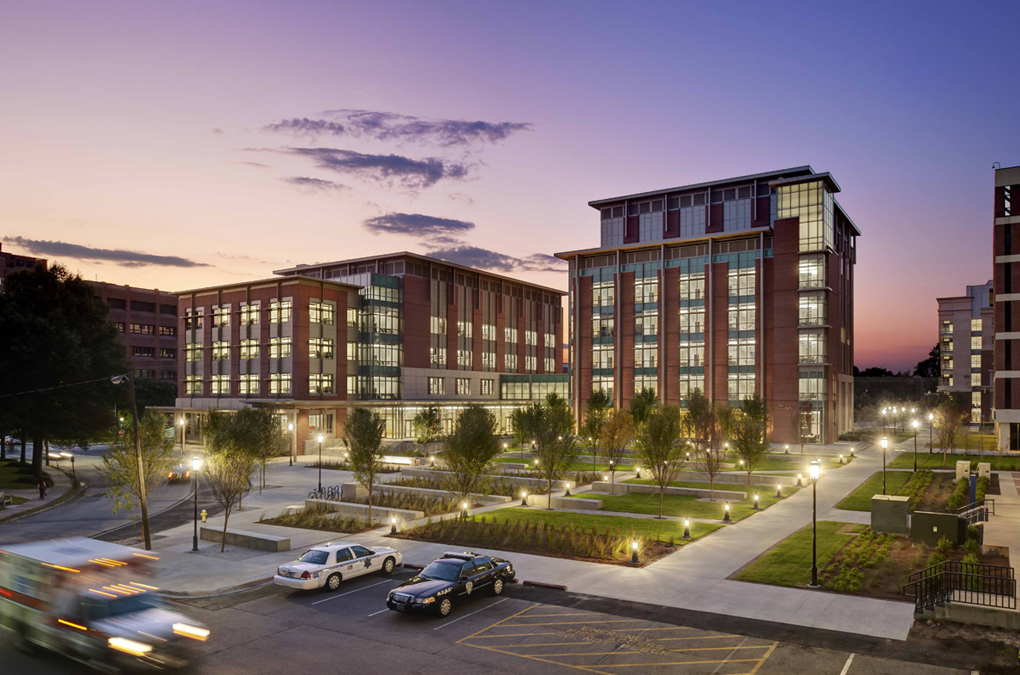Goody Clancy and Stevens & Wilkinson announced that two new research buildings on the campus of the Medical University of South Carolina in Charleston, S.C. were formally dedicated late in 2011.
The two buildings add 208,000 square feet of collaborative research space to the campus. The James E. Clyburn Research Center comprises two buildings, the Drug Discovery Building and the Bioengineering Building. The research center brings together scientists, faculty and students from the state’s three research universities: MUSC, the University of South Carolina and Clemson University, as well as representatives from private industry, to advance biomedical research and applications and speed up the process of technology transfer.
The project team includes: Goody Clancy, Boston, MA (Design Architect), led by principal Roger Goldstein, FAIA, LEED AP; Stevens & Wilkinson SC, Columbia, SC (Architect of Record, Mechanical/Electrical, Civil and Structural Engineer), led by principal Robby Aull, AIA, ACHA, LEED AP; Brasfield & Gorrie, LLC, Birmingham, AL (General Contractor); Seamon Whiteside + Associates, Mount Pleasant, SC (Landscape Architect); SST Planners, Arlington, VA (Lab Planners); and Vermeulens Cost Consultants, Boston, MA (Cost Consultant). Vanderweil, Boston, MA also served as the Mechanical Design Engineer for the Drug Discovery Building. BD+C
Related Stories
| Oct 15, 2014
Harvard launches ‘design-centric’ center for green buildings and cities
The impetus behind Harvard's Center for Green Buildings and Cities is what the design school’s dean, Mohsen Mostafavi, describes as a “rapidly urbanizing global economy,” in which cities are building new structures “on a massive scale.”
| Oct 15, 2014
Final touches make 432 Park Avenue tower second tallest in New York City
Concrete has been poured for the final floors of the residential high-rise at 432 Park Avenue in New York City, making it the city’s second-tallest building and the tallest residential tower in the Western Hemisphere.
| Oct 14, 2014
Slash energy consumption in data centers with liquid-based ‘immersive-cooling’ technology
A new technology promises to push the limits of data center energy efficiency by using liquid instead of air to cool the servers.
Sponsored | | Oct 14, 2014
3 color trends drive new commercial exterior color collections
Collectively as a society, we help create color trends, which shape our businesses, recreational facilities, healthcare centers, and civic buildings. These iconic colors are now appearing in Valspar's new color collections. SPONSORED CONTENT
| Oct 14, 2014
Get inspired with the top 10 TED talks about cities
The TED talks, none of which are longer than 20 minutes, feature speakers such as architect Moshe Safdie, Rio de Janeiro Major Eduardo Paes, and animal behaviorist Amanda Burden.
| Oct 14, 2014
Proven 6-step approach to treating historic windows
This course provides step-by-step prescriptive advice to architects, engineers, and contractors on when it makes sense to repair or rehabilitate existing windows, and when they should advise their building owner clients to consider replacement.
| Oct 14, 2014
Richard Meier unveils design for his first tower in Taiwan
Taiwan will soon have its first Richard Meier building, a 535-foot apartment tower in Taichung City, the country’s third-largest city.
| Oct 13, 2014
The mindful workplace: How employees can manage stress at the office
I have spent the last several months writing about healthy workplaces. My research lately has focused on stress—how we get stressed and ways to manage it through meditation and other mindful practices, writes HOK's Leigh Stringer.
| Oct 13, 2014
Debunking the 5 myths of health data and sustainable design
The path to more extensive use of health data in green building is blocked by certain myths that have to be debunked before such data can be successfully incorporated into the project delivery process.
Sponsored | | Oct 13, 2014
The problem with being a customer-centric organization
Kristof De Wulf, CEO of InSites Consulting, argues that the effects of customer-centricity typically don’t endure, leading only to temporary improvements in company performance. SPONSORED CONTENT

















